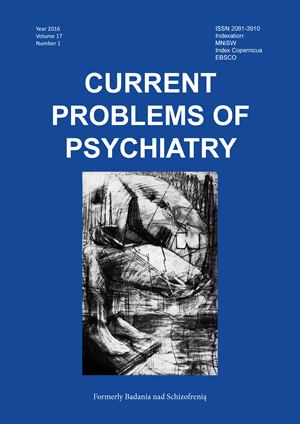Mechanizmy promujące i hamujące proces komórkowej degradacji proteasomalnej
DOI:
https://doi.org/10.1515/cpp-2016-0007Słowa kluczowe:
proteasom, lizosom, UPS – system ubiwiktyna-proteasomAbstrakt
Zaburzenia procesu degradacji nieużytecznych komórkowych białek leżą u podstaw wielu chorób. Niniejszy artykuł omawia jeden z najważniejszych systemów usuwających nieprawidłowe białka. Opisany został proces ubikwitynacji białek przeznaczonych do degradacji proteasomalnej. Przedstawiona została budowa proteasomów 26S, 20S oraz mechanizm działania systemu ubikwityna-proteasom. Proteasomalny system proteolityczny jest systemem wysoce wyspecjalizowanym i zorganizowanym. Dla prawidłowego funkcjonowania komórki istotne znaczenie ma szczególnie proteaza - proteasom 26S. To ona rozpoznaje i degraduje zaznaczone białka. Inhibicja szlaku proteasomów prowadzi do zatrzymania cyklu komórkowego i apoptozy.
Sprawna degradacja białek komórkowych przez szlak UPS (ubikwityna-proteasom) jest istotna dla transdukcji sygnału, regulacji transkrypcji, odpowiedzi na stres oraz kontroli czynności receptorów komórkowych.
Rozwój wielu chorób ma swoje podłoże w dysfunkcji szlaku UPS. Zaliczamy do tej grupy takie choroby jak: nowotwory, zaburzenia neurodegeneracyjne, o podłożu immunologicznym i infekcyjnym. Opracowanie metod farmakologicznej interwencji w funkcjonowanie tego układu staje się wielkim wyzwaniem. Zastosowanie swoistych, niskocząsteczkowych inhibitorów proteasomu i enzymów katalizujących ubikwitynację daje nadzieję na nowe, celowane terapie.
Bibliografia
1. Borissenko L., Groll M.: 20S proteasome and its inhibitors: crys-tallographic knowledge for drug development. Chem Rev. 2007; 107:687-717.
2. O’Neill L.A., Bryant C.E., Doyle S.L.: Therapeutic targeting of Toll-like receptors for infectious and inflammatory diseases and can-cer. Pharmacol. Rev., 2009; 61: 177-197.
3. Tsou W.L., Sheedlo M.J., Morrow M.E., Blount J.R., McGregor K.M., Das C., Todi S.V.: Systematic analysis of the physiological importance of deubiquitinating enzymes. PLoS One, 2012; 7: e43112.
4. Bury M., Niemierko A.: Proteasomalna degradacja białek komór-kowych. Postępy Biol. Kom., 2005; 32: 435-448.
5. Grzelakowska-Sztabert B.: Nagroda Nobla z chemii za 2004 rok - docenienie kontrolowanej, zależnej od ubikwityny, proteolitycz-nej degradacji białek. Postępy Biol. Kom., 2005; 32: 3-12.
6. Jurczyszyn A., Skotnicki A.B.: Proteasome inhibition as a novel therapeutic target in neoplasmatic diseases. Adv. Clin. Exp. Med., 2006; 15: 309–320.
7. Rechsteiner M., Realini C., Ustrell V.: The proteasome activator 11 S REG (PA28) and class I antigen presentation. Biochem. J., 2000; 345: 1-15.
8. Myung J., Kim K.B., Crews C.M.: The ubiquitin-proteasome pathway and proteasome inhibitors. Med. Res. Rev., 2001; 21: 245-273.
9. Wolf D.H., Hilt W.: The proteasome: a proteolytic nanomachine of cell regulation and waste disposal. Biochim. Biophys. Acta, 2004; 1695: 19-31.
10. Kisselev A.F., Callard A., Goldberg A.L.: Importance of the different proteolytic sites of the proteasome and the efficacy of inhibitors varies with the protein substrate. J. Biol. Chem., 2006; 281: 8582-8590.
11. Richardson P.G., Mitsiades C., Hideshima T., Anderson K.C.: Proteasome inhibition in the treatment of cancer. Cell Cycle, 2005; 4: 290-296.
12. Sprangers R., Kay L.E.: Quantitative dynamics and binding studies of the 20S proteasome by NMR. Nature, 2007; 445: 618-622.)
13. Navon A., Ciechanover A.: The 26 S proteasome: from basic mechanisms to drug targeting. J. Biol. Chem., 2009; 284: 33713-33718.
14. Sorokin A.V., Kim E.R., Ovchinnikov L.P.: Proteasome system of protein degradation and processing. Biochemistry, 2009; 74: 1411-1442.
15. Xie Y.: Structure, assembly and homeostatic regulation of 26S proteasome. J. Mol. Cell Biol., 2010; 2: 308-317.
16. Maliński M., Cichocki M.: Inhibicja aktywności proteasomu, jako nowa strategia w terapii i chemioprewencji nowotworów. Postępy Hig. Med. Dośw., 2013; 67: 90-106.
17. Miller Z., Ao L., Kim K.B., Lee W.: Inhibitors of the immunoproteasome: current status and future directions. Curr. Pharm. Des.,2013; 19: 4140-4151.
18. Glickman M.H., Ciechanover A.: The ubiquitin-proteasome proteolytic pathway: destruction for the sake of construction. Physiol. Rev., 2002; 82: 373-428.
19. Murata S., Takahama Y., Tanaka K.: Thymoproteasome: probable role in generating positively selecting peptides. Curr. Opin. Immunol., 2008; 20: 192-196.
20. Ikeda F., Crosetto N., Dikic I.: What determines the specificity and outcomes of ubiquitin signaling? Cell, 2010; 143: 677-681.
21. Mukhopadhyay D., Riezman H.: Proteasome-independent func-tions of ubiquitin in endocytosis and signaling. Science, 2007; 315: 201-205.
22. Pandey U.B., Nie Z., Batlevi Y., McCray B.A., Ritson G.P., Nedelsky N.B., Schwartz S.L., DiProspero N.A., Knight M.A., Schuldiner O., Padmanabhan R., Hild M., Berry D.L., Garza D., Hubbert C.C., Yao T.P., Baehrecke E.H., Taylor J.P.: HDAC6 rescues neurodegeneration and provides an essential link between au-tophagy and the UPS. Nature, 2007; 447: 859-863.
23. Martinez-Forero I., Rouzaut A., Palazon A., Dubrot J., MeleroI.: Lysine 63 polyubiquitination in immunotherapy and in cancer-promoting inflammation. Clin. Cancer Res., 2009; 15: 6751-6757.
24. Tsou W.L., Sheedlo M.J., Morrow M.E., Blount J.R., McGregor K.M., Das C., Todi S.V.: Systematic analysis of the physiological importance of deubiquitinating enzymes. PLoS One, 2012; 7: e43112.
25. Ciechanover A.: Intracellular protein degradation: from a vague idea thru the lysosome and the ubiquitin-proteasome system and onto hu-man diseases and drug targeting. Hematology, 2006; 1-12: 505-506.
26. Paul S.: Dysfunction of the ubiquitin-proteasome system in multiple disease conditions: therapeutic approaches. Bioessays, 2008; 30: 1172-1184.
27. Dziewulska D., Rafałowska J.: Rola zaburzeń przestrzennej bu-dowy białek w patomechanizmie chorób układu pozapiramido-wego. Neurol. Neurochir. Pol., 2005; 39: 397-404.
28. Nukina N.: Pathomechanism of polyglutamine diseases and strategic design for their therapies. Rinsho Shinkeigaku, 2008; 48: 913-914.
29. Seo H., Sonntag K.C., Kim W., Cattaneo E., Isacson O.: Proteasome activator enhances survival of Huntington's disease neuronal model cells. PLoS One, 2007; 2: e238.
Pobrania
Opublikowane
Numer
Dział
Licencja
Prawa autorskie (c) 2016 Autorzy

Praca jest udostępniana na licencji Creative Commons Attribution-NonCommercial-NoDerivatives 3.0 Unported License.


